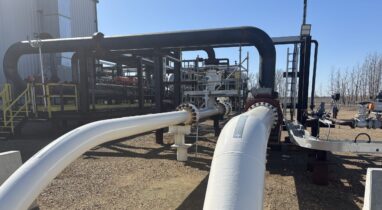Pillars of Decarbonization, the second report from Clean Prosperity’s Net-Zero Pathways for Canada project, examines common findings across models of five distinct futures for Canada’s energy system, all of which lead to net-zero greenhouse gas emissions by 2050. The five net-zero pathways were designed by Clean Prosperity and modelled by Navius Research.
Browse the report online, or download a PDF version with footnotes or endnotes.
The pathways each simulate conditions that favour different energy technologies: electrification, electrification largely from renewable energy sources, fossil fuels, bioenergy, and hydrogen.
All the pathways are constrained to achieve a net-zero target defined as 50 Mt of CO2e emissions per year in 2050, which is notably more aggressive than other Canadian net-zero modelling research.
The Pillars of Decarbonization report identifies three common themes — pillars — across the modelled pathways. These pillars are aspects of the net-zero transition that we believe merit consideration regardless of the mix of energy technologies that define Canada’s net-zero future. The three pillars are:
1. Electrification
Electricity use increases significantly across all five pathways, accounting for up to 40% of total energy use across the economy by 2050, compared to 17% in 2020.
Depending on the pathway, this jump in electricity demand requires an increase in generation of 43% to 74%, much of which comes from new solar and wind development. These renewable sources account for 36%–54% of generation by mid-century, up from 7% in 2020.
2. Alternative fuels
Our modelling shows a dramatic increase in renewable natural gas (RNG) consumption across four of our five net-zero pathways, accounting for 15%–26% of final energy use by 2050. The Navius model favours deploying RNG as part of bioenergy with carbon capture and storage (BECCS) systems to deliver the scale of net-negative emissions needed to achieve our aggressive 50 Mt CO2e/year net-zero target.
In contrast, we see only a modest deployment of hydrogen as an energy carrier, at 2%–5% of final energy use. Even this low level of hydrogen use requires significant amounts of new infrastructure.
3. Carbon capture and removal
We see considerable growth in onshore carbon capture, utilization and storage (CCUS) — between 89 and 206 Mt of CO2 captured per year across all pathways. Even in the pathway that simulates high dependence on renewable energy, our model shows significant CCUS, despite the near elimination of oil and gas production.
The model also shows high expectations for direct air capture (DAC) technology to remove CO2 from the atmosphere, in pathways that don’t rely on high deployment of RNG-powered BECCS for net-negative emissions. Both BECCS and DAC are in the early stages of commercialization; their development would need to accelerate significantly to meet the model’s expectations.
Comparing findings to research and planning
The report compares our findings to other Canadian net-zero studies and finds that in most cases, Clean Prosperity’s results are similar to those found in other research. One notable exception is RNG: compared to other studies, this project models much higher consumption of RNG, which the model deploys in BECCS systems to achieve our aggressive net-zero constraint.
The report also finds significant gaps between the current state of net-zero technology deployment and planning across Canada, and the modelled pathway requirements. Clean Prosperity argues that Canadian net-zero research needs to pay closer attention to this critical deployment gap.
Next steps: addressing the “30-50 gap”
The first report from the Net-Zero Pathways for Canada project analyzed the impact of current federal climate policy on emissions reductions by 2050. Current policy is focused on achieving Canada’s 2030 climate target, and our modelling has found that simply continuing current policies through to 2050 would lead to an emissions overshoot of more than 400 Mt of CO2e per year. We call this the “30-50 gap,” and the final report of the Net-Zero Pathways for Canada project will feature recommendations on how to close it.
The project’s next interim report will look at how our three pillars can apply to decarbonizing high-emitting sectors of the Canadian economy, and will examine how to operationalize net zero at the provincial level. We will also release supporting briefs that examine the spatial and land-use considerations associated with various net-zero projections. The first of these will focus on CCUS deployment and will be released in early 2024.
We invite your feedback on Clean Prosperity’s Net-Zero Pathways for Canada project, at research@cleanprosperity.ca.




